TANZANIA
Plants and Animals

Plants and Animals
Popular destinations TANZANIA
| Pemba | Zanzibar |
Plants and Animals
Plants
Ecologically Tanzania can be divided into a number of zones:
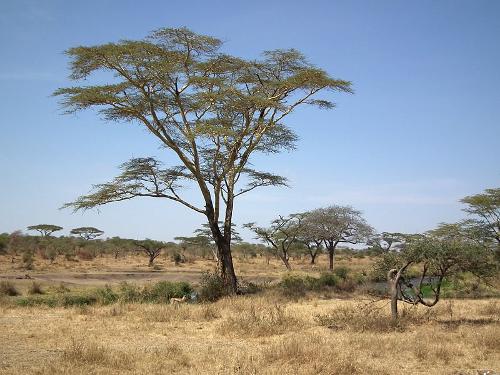 Fever tree in TanzaniaPhoto: Nevit Dilmen CC 3.0 Unported no changes made
Fever tree in TanzaniaPhoto: Nevit Dilmen CC 3.0 Unported no changes made
The acacia savanna forest has a very varied flora with about 2500 plant species. The forests are located on the central plateau and the northern grassland areas. The Serengeti steppes are mainly covered with red ottoes and various cyper grasses. The vast savannah forest is dominated by acacia trees; Tanzania has 40 native species. A special acacia species is the yellow-colored Acacia xanthopholoea or fever tree, which is common along water surfaces.
The south of Tanzania consists largely of forested savannah or Miombot, with about 15 species of Brachystegia and long grasses. The very remarkable solitary jagged baobab trees are found all over Tanzania, especially below the 1300 meter line.
The lowland rainforest can be found on the lower slopes of the Usambara Mountains in the east. This mountain range has an unbroken forest area with the largest height differences in East Africa. This is one of the richest biological habitats in Africa with 276 registered trees of which 50 are native. In total, Tanzania is only 1.5% covered with dense forests.
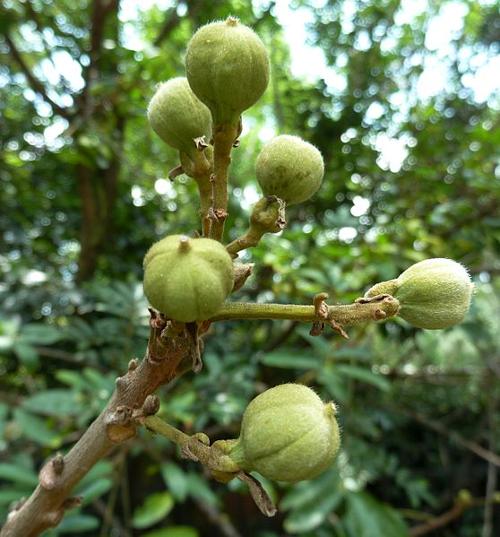 Trichilia Emetica, TanzaniaPhoto: JMK CC 3.0 Unported no changes made
Trichilia Emetica, TanzaniaPhoto: JMK CC 3.0 Unported no changes made
The riverine forests and evergreen forests line the major rivers and the slopes of Lake Manyara. The forests consist of tall trees such as Trichilea emetica, Bridelia micrantha and Ficus sycamorus. Other well-known appearances are the borassus and the date palm.
Mountain forests grow between a height of 1200 meters and the tree line of 3000 meters. Due to the varied rainfall, there are more species in some places than in others. Macaranga kilimandscharica is mainly found on the slopes of Kilimanjaro. Juniper, olive trees, Nuxia congesta, ivy, camphor and the 30 meter high conifer Podocarpus milanjianus predominate on the rainier northern and western slopes.
Beneath the trees is a dense vegetation of shrubs and wildflowers, including diligent lizzie, begonia, large tree ferns, balsam and Cape violets.
Slightly higher up the slopes are the three-meter-high feather-like heather Erica excelsa and the ragwort Senecio johnstonii. The vegetation between 2800 and 4000 meters altitude can also be called very diverse with Erica arborea, Erica exelsa, Hypericum revolutum, Helichrysum, yellow protea, a rocket species and different types of lobelia. The Lobelia deckenii and the Senecio kilimanjari only grow on Kilimanjaro. Tanzania's national tree is the African grenadilla.
Various plant species can also be found at an altitude of 4000-5000 meters. About 55 species still grow in this highland wasteland, including colored lichens and plants such as the Haplocarpa rueppelii and the Haplosciadium abyssinicum.
Mangrove forests are found on the coast of the Indian Ocean, usually in the form of shrubs and lower trees. Directly behind the mangrove area there are slightly high coastal forests.
The 25 million year old Eastern Arcs, 13 forested massifs, are of great ecological significance. These forests are among the areas with the greatest biodiversity in the world and are the oldest and most stable in Africa. Thanks to the constant moist air drifting in from the Indian Ocean, these forests have been around for 30 million years. The forests are home to 16 plant genera, 75 vertebrate species and approximately 1000 native invertebrate species. Over the past century, however, five of the Eastern Arc forests have lost more than three-quarters of their afforestation due to human intervention.
Tropical rainforest is limited to parts of high mountains. On Zanzibar, natural vegetation has been almost completely replaced by planted dense coconut palm groves.
Special trees
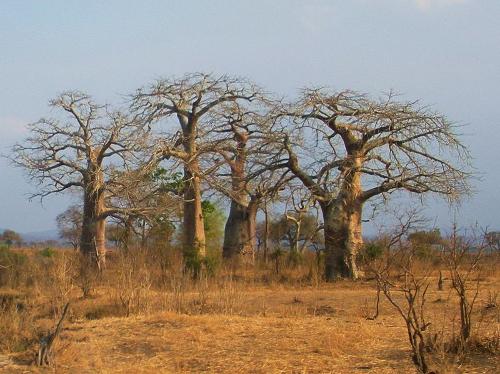 Babobab, TanzaniaPhoto: Prof. Chen Hualin CC 4.0 International no changes
Babobab, TanzaniaPhoto: Prof. Chen Hualin CC 4.0 International no changes
In cities and towns, the flame trees with their red-orange flowers are a striking and common appearance.
Related to the flame tree is the jacaranda, which has a dense bath crown and comes in many different shapes.
Mango trees are planted in the vicinity of many houses, with the well-known very edible fruits.
Very striking are the flowering flame tree and the coral tree with its spiny trunk and leathery leaves.
The candelabra resembles a cactus and the 18 meter high sausage tree has typical fruits that can grow up to a meter long and kilos.
Tanzania's most striking tree is the Adansonia digitata or baobab, known for its irregular shapes and strange branches. The fruits are a delicacy for monkeys, and the tree is also called monkey bread tree. The baobab can become several tens of meters high and grow very old.
The most recognizable acacia is the Acacia tortilis or umbrella tree, which can grow up to twenty meters high and has centimeters long thorns.
The sycamore fig is a wild fig that can reach a height of 20 meters. The round fruits are eaten by many animals, while the leaves are a delicacy for elephants.
Animals: general
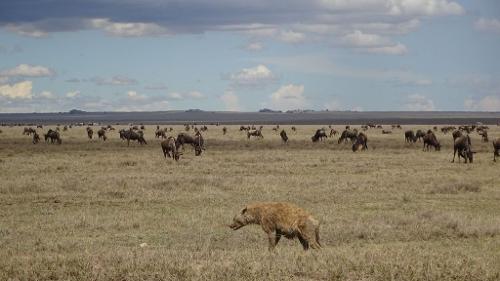 Animal world, TanzaniaPhoto: Tessa Verrijp in the public domain
Animal world, TanzaniaPhoto: Tessa Verrijp in the public domain
Tanzania's animal world is primarily that of the savannah, and is characterized by numerous antelopes (of which the blue or striped wildebeest is by far the most common), buffaloes, warthogs, giraffes, hippos, zebras, rare pointed-lipped rhinoceroses, elephants, lions, panthers, spotted hyenas, hyena dogs, and so on. The fact that there are so many different animal species in Tanzania is a result of the vegetation of the country and the height differences.
The fauna of the forests includes several monkey species and in the west the chimpanzee; the wildlife of the coastal forests differs somewhat from that of the inland forests. The fauna on the high peaks has an alpine character.
The bird world is very varied with more than 1000 species.
Reptiles and amphibians include hundreds of species.
The fish fauna of the rivers is quite poor, but the lakes (Lake Victoria and Tanganyika) contain large numbers of species, especially among the mouth brooders and relatives.
The other animal groups are very rich in species but little known. Off the coast are coral reefs with a typical tropical Indo-Pacific fauna.
The island of Zanzibar is close to the mainland as far as the animal world is concerned, albeit that there are some endemic elements, such as a duiker (antelope) and a frilly monkey.
Tanzania includes a large number of national parks and reserves, some of which are among the most important and famous in the world (Serengeti National Park, Ngorongoro Crater). Nature conservation has consistently continued after independence, despite poaching and the poor economic situation.
Mammals
Tanzania is home to many large mammals, more than 80 species. The famous "big five" are also found in Tanzania, namely elephant, lion, leopard, hippo and buffalo.
Short descriptions:
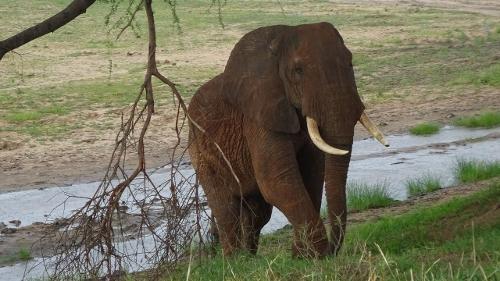 African Elephant, TanzaniaPhoto: Tessa Verrijp in the public domain
African Elephant, TanzaniaPhoto: Tessa Verrijp in the public domain
The African elephant is the largest land mammal in the world, can reach a height of 3.5 meters and males can weigh more than 6000 kg. The trunk can reach a length of 1.7 meters, the tusks can reach almost two meters. A group of elephants consists of females with young and is led by the oldest female. Bull elephants live solitary. An elephant cub weighs about 130 kilograms at birth and is one meter high. Elephants live an average of 60 to 70 years. Two types of elephants live in Tanzania, the African bush elephant and the forest elephant. Adults eat leaves, branches, bark and fruits.
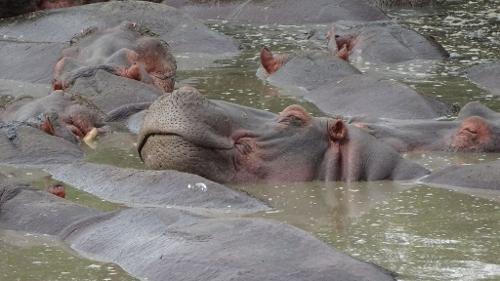 Hippotamus, TanzaniaPhoto: Tessa Verrijp in the public domain
Hippotamus, TanzaniaPhoto: Tessa Verrijp in the public domain
The hippopotamus lives in herds in most of Tanzania's major rivers and lakes and weighs up to 2500 kg, varies in length from 3 to 4 meters and grows to about 1.5 meters in height. They spend most of their life in the water, but they can also manage well on land. Adult animals have no natural enemies.
The black or point-lipped rhinoceros is still in danger of extinction; white rhinos are extinct in Tanzania. An adult black rhino can weigh up to 2500 kg, reach an average height of 1.75 meters and a length of more than three meters. Rhinos have no natural predators, only young animals sometimes fall prey to lions or a group of hyenas. The rhino's poor eyesight is offset by excellent hearing.
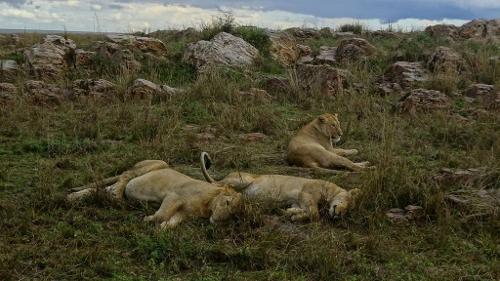 Lions, TanzaniaPhoto: Tessa Verrijp in the public domain
Lions, TanzaniaPhoto: Tessa Verrijp in the public domain
The lion is Africa's largest feline. A groop consist of six to twelve lionesses and their cubs and one or more males. They can grow up to two meters in length and weigh up to 200 kg. Generally, the females hunt and feed on antelopes and other small game, but giraffes are also attacked. The lions in Lake Manyara National Park have one striking feature: they climb trees!
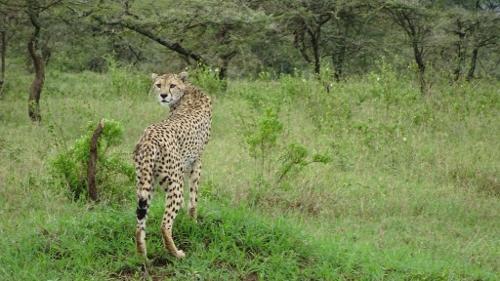 Cheetah, TanzaniaPhoto: Tessa Verrijp in the public domain
Cheetah, TanzaniaPhoto: Tessa Verrijp in the public domain
The leopard lives solitary and usually hunts at night. The leopard is so strong that it can carry an adult impala up a tree. They live on plains as well as in forests.The cheetah is one of the fastest mammals in the world. Over short distances it can reach more than 100 km per hour. Young cheetahs often fall prey to lions, leopards and spotted hyenas. Caracals live in Tanzania's drier areas and are very similar to lynx in appearance. The serval is a bit smaller than the cheetah and lives in long grass and reeds. The African wildcat is one of the ancestors of the domestic cat. It occurs throughout Africa, up to the outskirts of cities.
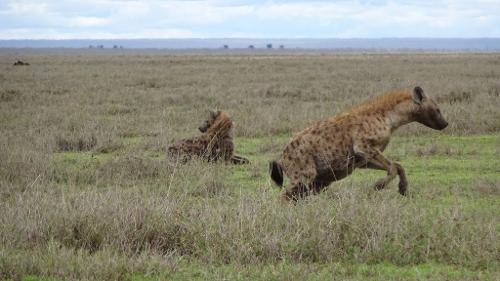 Spotted Hyena, TanzaniaPhoto: Tessa Verrijp in the public domain
Spotted Hyena, TanzaniaPhoto: Tessa Verrijp in the public domain
The spotted hyena is a scavenger but also hunts in groups for antelopes, zebras and even the dangerous buffalo. The striped hyena is somewhat smaller than the spotted hyena and is sometimes seen in Northern Tanzania.
The black-backed jackal and the striped jackal hunt small mammals, but are also scavengers. The blackback lives on the open savannah, the striped jackal prefers a wooded environment.
The African wild dog is unique in the animal kingdom. They are very good hunters working together in groups of 10-15 specimens. This animal is in danger of extinction.
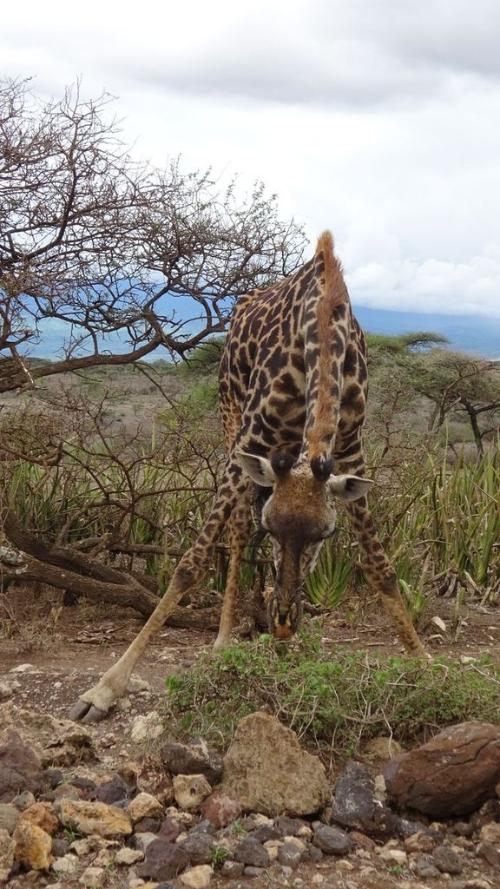 Giraffe, TanzaniaPhoto: Tessa Verrijp in the public domain
Giraffe, TanzaniaPhoto: Tessa Verrijp in the public domain
The Maasai or Kenya giraffe is found in Tanzania, which stands out for its irregular spotting pattern. A male can grow to 5.5 meters and even a newborn giraffe is 1.75 in size. Giraffes live on leaves, fruits, flowers and tree bark, but have a strong preference for the thorny acacia. They live in groups of 10 to 25 animals.
Only the common or burchell's zebra is found in Tanzania. A zebra herd consists of one stallion and a number of mares with foals. During the migration, the small herds grow into large herds of thousands of individuals. The zebra grows to about 1.5 meters high and feeds mainly on grass.
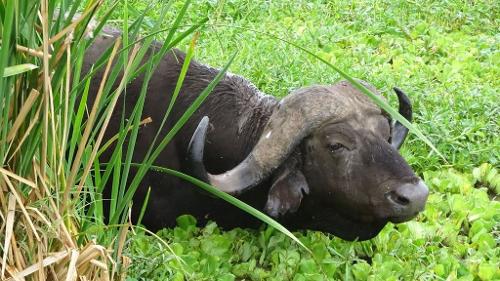 African buffalo, TanzaniaPhoto: Tessa Verrijp in the public domain
African buffalo, TanzaniaPhoto: Tessa Verrijp in the public domain
The African buffalo is very heavily built and has a height of up to 150 cm. The horns can grow up to 1.5 meters long. They live in herds of a few dozen to several thousand individuals.
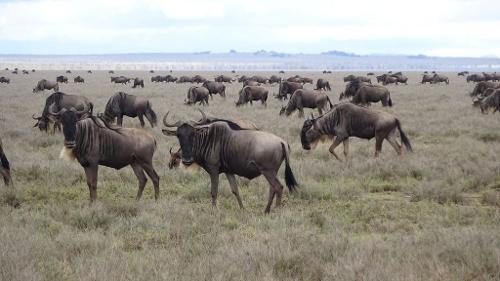 Wildebeast, TanzaniaPhoto: Tessa Verrijp in the public domain
Wildebeast, TanzaniaPhoto: Tessa Verrijp in the public domain
The (white-bearded) wildebeest is most common in Africa. Wildebeest normally live in groups of about 30 animals, but tens of thousands of wildebeest gather during the annual migration between Serengeti Masai-Mara.
The eland is the largest antelope in Africa, lives on the vast grassy plains and migrates in herds of about 20 animals. The male's helical horns can reach a length of 1.25 meters.
Other antelope species include the hartebeest (two species: Coke's hartebeest and topi), the sable antelope, horse antelope, oryx or skewer, common waterbuck, large kudu, lesser kudu, bushbuck, reedbuck, gray duiker, dik-dik, and oribi.
The Grant's gazelle has graceful long horns and lives in herds of about 30 animals.
The Thomson gazelle is the most common gazelle in Tanzania; in all of East Africa there are about 1 million in number.
Other gazelle species are the impala and the giraffe gazelle or geruka.
The warthog is the only African wild boar. The warty outgrowths on its head (four in the females and six in the males) are very characteristic.
The brush boar is mainly active at night and is only sporadically found in Tanzania.
The bat-eared fox is silver-gray in color and they mainly eat termites. They mainly live on grassy plains and slightly wooded terrain.
The white-tailed mongoose is very large and occurs throughout Tanzania. The animal lives solitary and hunts invertebrates, small mammals, but also eats fruits.
Other mongooses are the gray mongoose and the zebra mongoose.
The tiger cat is a nocturnal animal, lives solitary and hunts large invertebrates and small mammals.
Other small predators include the common genet, the African civet and the rattle or honey badger.
The chimpanzee is a great ape, about 120 cm in size and lives in wooded areas in groups of up to 100 animals.
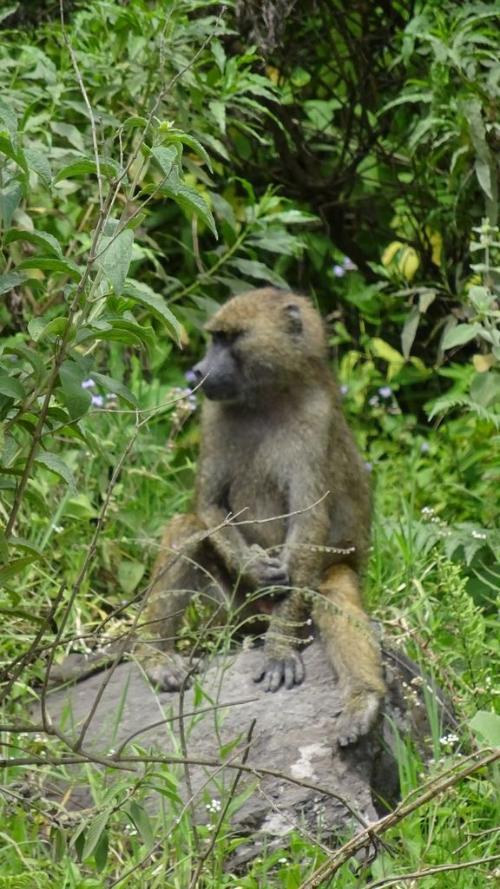 Baboon, TanzaniaPhoto:Tessa Verrijp in the public domain
Baboon, TanzaniaPhoto:Tessa Verrijp in the public domain
The baboon is the largest monkey in Africa and lives both in trees and on the ground. They live in groups of up to 100 animals, and eat plant species, insects, eggs and even small mammals.
Other monkeys include the green meerkat, the blue meerkat, colobus or fringed monkey (black and white fringed monkey, red fringed monkey, Uhehe red fringed monkey) and the very rare Sanje crested mangabey, discovered only in 1979. Kirk’s red fringed monkey lives only on Zanzibar.
The jumping hare is a rodent, but it is explicitly not a member of the hare family. It is about 80 cm tall, lives in tunnels and feeds on roots, grass and other plants.
The great galago is a small primate species and a distant relative of the lemurs of Madagascar. Galagos eat everything, but prefer fruit, especially figs. The Senegal galago is also found in Tanzania.
Unbelievable as it may seem, hyraxes are related to the elephant. They eat leaves, flowers and fruits. The tree badger is related to the cliff badger, but lives at night.
The porcupine can grow up to three meters long, including spines. In Tanzania there are two species that, except in dense forest, are found everywhere in Tanzania.
The aardvark somewhat resembles a pig, is solitary and only active at night. With its long sticky tongue it catches termites, ants and larvae.
Birds
Tanzania has more than 1000 bird species, including some very rare ones, such as the Udzungwa partridge (only discovered in 1991), the Abbotts duiker and the green Pemba pigeon. The great variety in bird species is mainly caused by the many climates in Tanzania and the different vegetation forms.
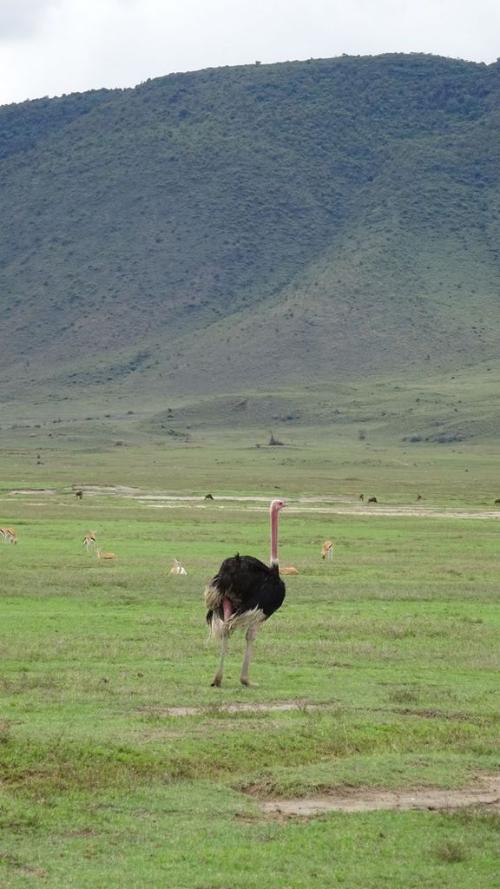 Ostrich, TanzaniaPhoto: Tessa Verrijp in the public domain
Ostrich, TanzaniaPhoto: Tessa Verrijp in the public domain
The ostrich living in groups is the largest and heaviest bird in the world. It is a flightless bird that can reach speeds of up to 50 km per hour.
The secretary bird is a bird of prey that hunts rodents, insects and reptiles. It hunts on the ground, but can also fly and sleeps in a thorn tree at night.
The Kori Bustard is the heaviest flying bird in Africa. A male specimen can reach a height of 1.20 meters and a weight of 18 kg. They hunt insects, reptiles and small rodents.
The scavenger marabou is a large stork species that lives in colonies. They also eat grasshoppers and frogs. Other stork species are the saddle-billed stork, the white stork, the African gaper, the Abdi-stork and the African nimmerzat.
The most common vultures in Tanzania are the white-backed vulture and the Rüppels vulture. Other vultures include the Egyptian vulture, the bearded vulture, the hooded vulture and the eared vulture.
The sacred ibis, a wader, is particularly notable for its bald black head and neck. It can be found on river banks, beaches and in swamps. They search for snails and crustaceans in the mud. The hadada ibis lives in pairs or small groups.
The African snake-neck bird resembles a cormorant and lives in inland waters and preferably around slow-flowing rivers. It catches its food underwater, piercing the fish with its dagger-like beak.
The white-breasted cormorant is the largest cormorant species in Africa and is also the most common. The smaller African pygmy cormorant is also found in Tanzania.
Other common waterfowl are the lesser and greater flamingo, the white pelican, the pink pelican, the hammerhead, the giant heron (largest heron species in the world), the cow heron, the blue heron, the black-headed heron, the purple heron, the spur-winged goose, the crown lapwing and the African jaçana or lily carpet.
The African bald eagle is closely related to the bald eagle. In East Africa there are also several other eagles, such as the fighting eagle, the crowned eagle, the black eagle, the bateleur (kind of snake eagle) and the steppe eagle. A special owl species is the Verreaux's eagle-owl and furthermore the African eagle-owl, the pearl-tailed owl and the barn owl.
The white-bellied turaco is a poor flyer and lives in wooded areas. The gray turaco is common in southern Tanzania.
Honey suckers always live near flowering plants, as they depend on honey, their main nutrient. There are many species in Tanzania, including the emerald, robin, green-throated, olive and amethyst honey sucker.
The red-billed token is one of the twenty token species that occur in Tanzania. They eat insects, small reptiles, seeds and fruits and nest in tree cavities. Other tokens are the Ethiopian Yellow-billed Tok, the Crested Tok and the Gray Tok.
The speckled mouse bird, like other mouse bird species, has soft, fur-like feathers. They eat fruits and live in colonies of 10-30 birds.
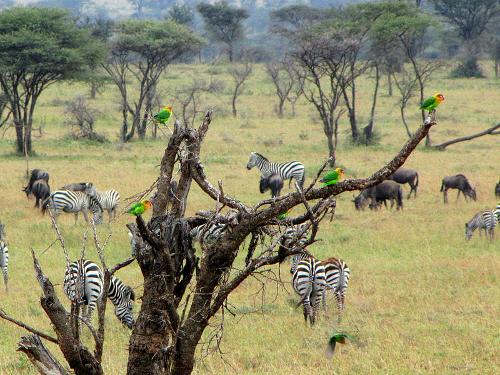 Fischer's Lovebirds in the Serengeti National Park, TanzaniaPhoto: D. Gordon E. Robertson CC 3.0 Unportedno changes
Fischer's Lovebirds in the Serengeti National Park, TanzaniaPhoto: D. Gordon E. Robertson CC 3.0 Unportedno changes
Fischer's lovebird is named after the 19th century explorer G.A. Fischer. The bird is native to Tanzania and only occurs in the north of the country on open grassy plains and agricultural areas.
The dwarf bee-eater is the smallest of the bee-eater family and grows only 15 centimeters in front. Not only do they eat bees, but also cicadas, hornets, wasps and dragonflies. Other species are the white-hooded bee-eater and the mountain bee-eater.
The red-billed oxpecker is a member of the starling family and eats ticks and blood-sucking flies from the backs of livestock and large wild mammals. Rare is the yellow-billed oxpecker.
The helmeted guineafowl is common in Tanzania. The bird mainly lives on the ground but stays high in trees overnight. They eat insects, snails, fruits and seeds. Another species is the vulture guineafowl.
The crested francolin is one of the sixteen species of the francolin. They look a bit like partridges, live mainly on the ground and nest in shallow cavities. The crested variety mainly lives in dry wooded areas.
The seed-eating dark red fire finch often nests near people. They live in colonies of 20-40 birds.
Weavers are large finches, weaving intricate hollow nests of grass. Each species makes its own typical nest. The black-headed weaver makes a nest in the shape of an onion.
The red-billed weaver is one of the most abundant birds on Earth and a pest to agriculture. Other species are the spectacle weaver, the mask weaver and the Speke's weaver.
Spur cuckoos are particularly at home on the ground and hunt insects, reptiles and small rodents there. In Tanzania, among other things, the eyebrow spur cuckoo and the blue-headed spur cuckoo occur.
The shield raven is the most common type of raven in Africa. They eat carrion, birds, insects, small rodents and eggs. A larger species is the white-necked crow.
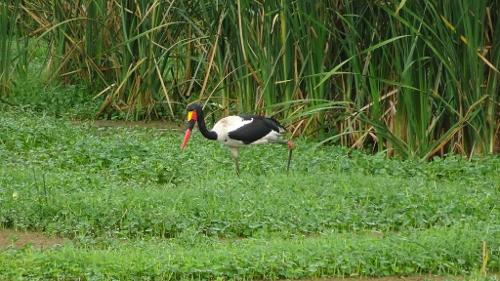 Stork, TanzaniaPhoto: Tessa Verrijp in the public domain
Stork, TanzaniaPhoto: Tessa Verrijp in the public domain
There are of course many more birds, including mountain rooster, tricolor glacier starling, Hildebrandt glacier starling, green-tailed glazed starling, blue long-tailed glacier starling, crowned crane, hornbill, Egyptian goose and Stork.
Several small birds with extremely long tails include the African paradise monarch, magpie shrike, red-throated widowfinch, rooster-tailed widowfinch, broad-tailed paradise wida, and Fischer's agapornis or "lovebird".
Reptiles and Amphibians
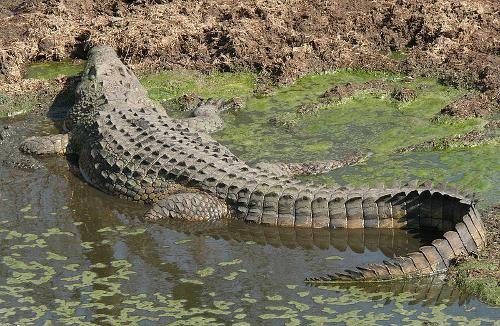 Nile Crocodile, TanzaniaPhoto: Haplochromis CC 3.0 Unported no changes made
Nile Crocodile, TanzaniaPhoto: Haplochromis CC 3.0 Unported no changes made
Most of the approximately 500 reptile species in Tanzania are harmless, but watch out for some poisonous snake species and of course for crocodiles. Many amphibians have adapted to the prolonged dry spells, simply disappearing underground for several months, waiting for the new rainy season.
The Nile crocodile grows to 5-7 meters long and can weigh up to 900 kg. They can also reach a high speed on land. They mainly eat fish and also mammals such as baboons, antelopes, wildebeest and occasionally people.
The Nile monitor is the largest lizard in Africa and can reach a length of two meters. They prefer to eat eggs, but also birds and small mammals. They climb trees but can also stay underwater for a long time.
With a length of no more than 130 cm, the savannah monitor is a lot smaller than the Nile monitor.
There are more than 80 types of skinks, a type of lizards. A number are found in East Africa, of which the African striped skink is the most common in Tanzania.
The three-clawed turtle grows to a maximum size of 90 cm and can weigh about 45 kg. It is green-brown in color and can be found in larger rivers, lakes and sometimes even in the sea. This turtle mainly eats fish and mollusks, but also fruits and insects.
Other turtles in Tanzania include the panther turtle, the African pond turtle, the pancake turtle, and the green turtle, the largest of the sea turtles.
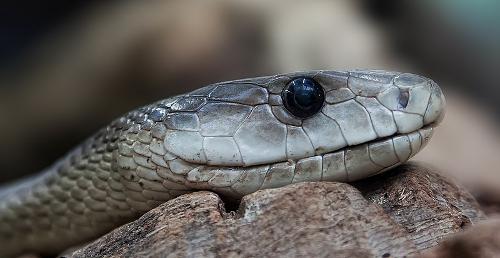 Black Mamba, TanzaniaPhoto: Safaritravelplus in the public domain
Black Mamba, TanzaniaPhoto: Safaritravelplus in the public domain
The black mamba can grow up to eight feet long and feeds on birds and small mammals. The black mamma is highly poisonous, as is the puff adder, which only grows to one meter in length. Unlike other snakes, the puff adder is viviparous.
Other snakes include the Mozambican spit cobra, the most common snake in Africa, the tree snake and the African rock python, Africa's largest snake.
The African bullfrog can grow up to 20 cm long, which is very large for a frog. In addition to worms and insects, they even occasionally eat small mammals.
The bottlenose dolphin is a marine mammal because it belongs to the dolphin family. The animal can grow to four meters long and weigh 650 kg. They swim in schools of a few dozen individuals around the island of Zanzibar.
The rare Chumbe coconut crab is the largest living land crab in the world. It climbs palm trees and can crack a coconut with its claws.
In October 2009, it was announced that the Kihansi Spray Toad or Kihansi vaporizer pad, a path that only occurs in the area of Kihansi waterfalls in Tanzania, is on the verge of extinction due to the construction of a dam. The amount of water in its habitat has therefore decreased by 90%.
Invertebrates
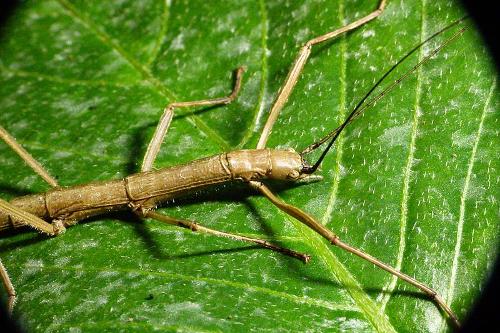 Stick insect, TanzaniaPhoto: L. Shyamal C 3.0 Unported no changes made
Stick insect, TanzaniaPhoto: L. Shyamal C 3.0 Unported no changes made
Several tens of thousands of invertebrate species live in Tanzania. Some can be dangerous to humans, such as poisonous spiders, malaria mosquitoes, scorpions and tsetse flies.
Stick insects can grow up to 20 cm. They almost only eat leaves. Some species have wings, but only males can fly.
There are about 2,000 mantis species worldwide. They catch small insects with their front legs. A Tanzanian species can grow up to 15 cm.
The dung beetle also comes in all shapes and sizes; they grow, for example, between 0.5 and 4 cm long. They feed on animal feces and are often eaten by mongooses and bat-eared foxes themselves.
The achaat snail has a shell that can grow to 10 cm and eats all kinds of vegetation. In some areas the snail is very harmful to agriculture.
The mopane worm is in fact a larva or caterpillar of the great night peacock. It only eats leaves of the mopane tree and is in turn eaten by the locals, for whom it is a protein-rich delicacy.
The golden wheel spider, of which the female grows to 5 cm, make very strong webs, in which even small birds get entangled. The spider is poisonous, but not deadly to humans.
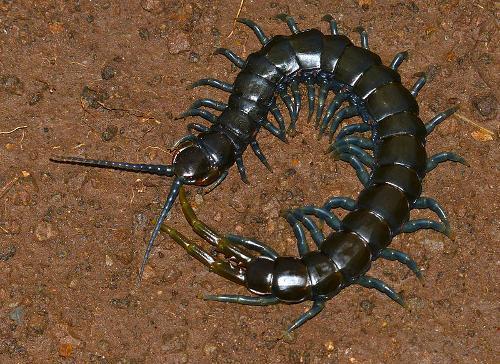 Centipede, TanzaniaPhoto:Bernard Dupont CC 2.0 Generic no changes made
Centipede, TanzaniaPhoto:Bernard Dupont CC 2.0 Generic no changes made
There are over 1000 species of centipedes (actually several hundred feet), many of which are found in Tanzania. The large varieties can grow up to 30 cm long. They eat dead and rotting plants.
Of the more than 2500 species of mosquitoes, many are found in East Africa and therefore also in Tanzania. The female Anopheles are very fond of human blood and are the carriers of the parasites that cause malaria.
The tsetse fly is also very dangerous to humans. Some species carry parasites that can cause sleeping sickness.
Goliath beetles can grow up to 10 cm and weigh about 100 grams. There are two species in Tanzania, Goliathus goliatus and Goliathus orientalis, both of which are excellent in flight.
The draft ant is the largest ant in the world; worker ants measure 33 mm, the queen grows to 52 mm. The queen lays tens of millions of eggs in a year. The migratory ant lives in wooded areas.
The Tanzanian long-clawed scorpion is neither very poisonous nor aggressive, it is black with brown legs and adults grow to about 8 cm in length.
Fishes
Many fish species are found in the pools, streams, rivers and lakes of Tanzania. The warm Gulf Stream of the Indian Ocean off the coast and around Zanzibar also has many fish species.
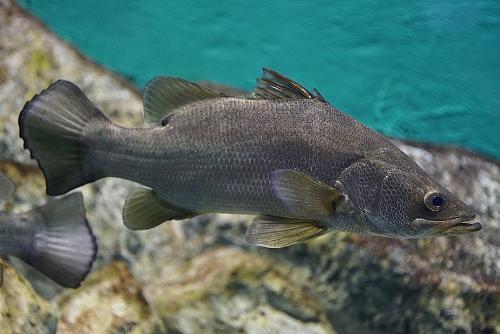 Nile Perch, TanzaniaPhoto: Daiju Azuma CC 4.0 International no changes made
Nile Perch, TanzaniaPhoto: Daiju Azuma CC 4.0 International no changes made
The Nile perch is the largest freshwater fish in the world and can reach a length of almost 2 meters and weigh 140 kg. This predatory fish lives in the major rivers and lakes, including of course Lake Victoria.
The Nile tilapia is a lot smaller than the Nile perch and can weigh 2 kg. This fish is widely eaten in East Africa and is also farmed there.
The tiger fish is a predatory fish that hunts smaller fish and crustaceans such as shrimps. It can grow up to 75 cm and weigh more than 18 kg.
The cichlid family consists of many hundreds of species, many of which are found in the great African lakes. Most cichlids are no larger than 20 cm.
The large grouper is one of the largest coral fish in the world and can live for decades. They often live in shallow water and eat crustaceans, fish, small turtles and even small sharks.
The black marlin can grow up to three meters in length and weigh about 180 kg. They hunt tuna, swordfish, squid and even dolphins.
The large barracuda can grow to almost two meters in length and feeds on small fish such as mullet, parrotfish and anchovies.
SERENGETI NATIONAL PARK
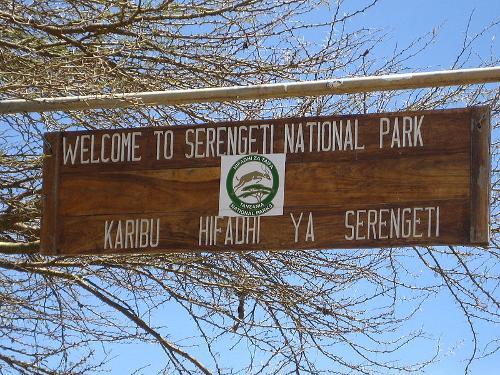 Entree sign Serengeti National Park, TanzaniaPhoto: Thomas Huston CC 3.0 Unported no changes made
Entree sign Serengeti National Park, TanzaniaPhoto: Thomas Huston CC 3.0 Unported no changes made
The Serengeti National Park (from 1951) is one of the most famous game reserves in the world and is a UNESCO World Heritage Site. Serengeti covers 14,763 km2. The entire Serengeti sco system includes the Maasi Mara in Kenya and the Ngorongoro Conservation Area, an area of approximately 25,000 km2. One third of the park consists of grassy plains ("Siringit" is Maasi for "where the land has no end"), and so-called "cups" stand out: mountains of large pebbles that have emerged from erosion. In the vicinity of the cups there is often more vegetation and therefore more game and poultry.
In the middle of the park is the Seronera Valley, one of the richest wildlife areas in the area. Well known is the seasonal migration of wildebeest and zebras between Serengeti and Masai Mara, involving millions of animals twice a year. Estimated populations include 150,000 zebras, 25,000 buffaloes, 200,000 Thomson gazelles, 8,000 giraffes.
In 2010 a new snake species was discovered in southwestern Tanzania, which was confirmed in early 2012 in the scientific journal Zootaxa. The snake is named after a 7-year-old girl and has been given the generic name Matilda's horned viper (Atheris matildae). Matilda's horned viper is yellow-black in color, has green eyes and two pointed horns on its head.
Sources
Heale, J. / Tanzania
Marshall Cavendish
Tanzania
Cambium
Vlugt, B. / Kenia, Tanzania, Zanzibar
Gottmer/Becht
Waard, P. de / Reishandboek Tanzania
Elmar
CIA - World Factbook
BBC - Country Profiles
Copyright: Team The World of Info